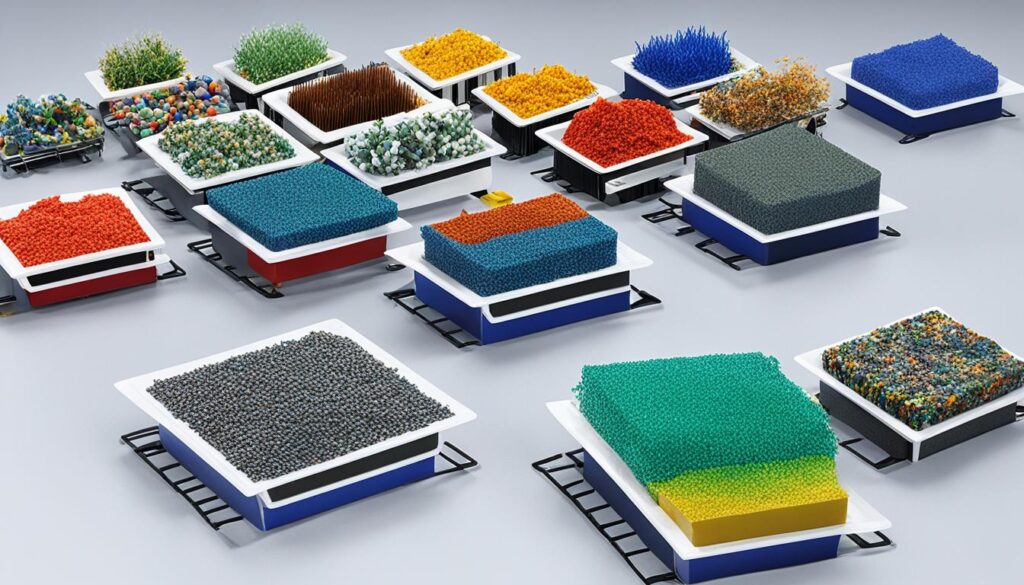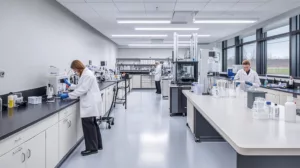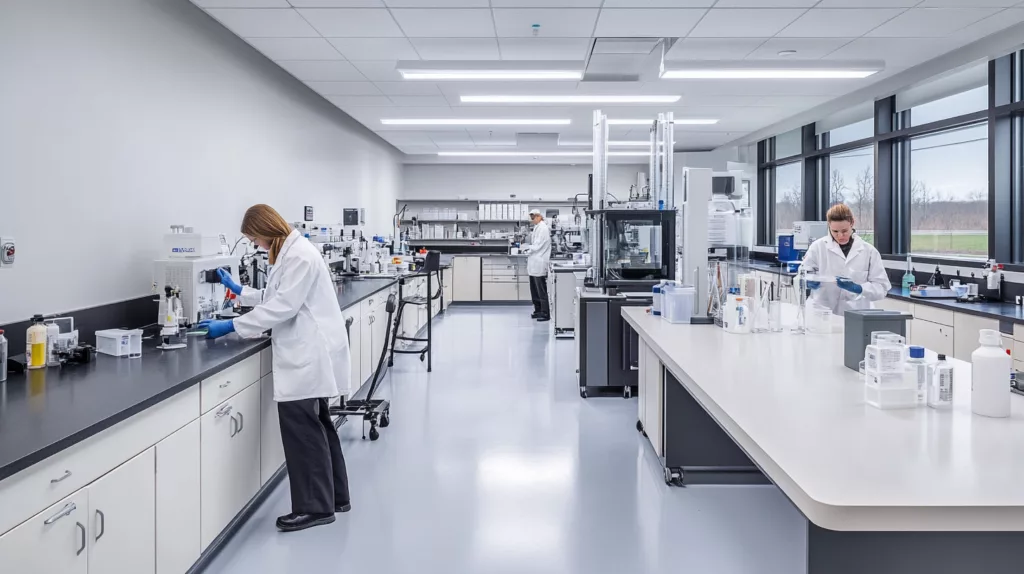Transformer potting is key in protecting electrical parts. It keeps them safe from the weather and physical stress. When we dip transformers into a protective coat, their electrical defense and reliability get better. We make sure our potting compounds can handle different work situations. This makes industrial transformers work better and more safely.
Key Takeaways
- Transformer potting safeguards components from environmental and mechanical stresses.
- Potting compounds enhance electrical insulation and reliability.
- Our solutions are designed to endure diverse operational conditions.
- Enhancing safety and performance of industrial transformers is our priority.
- Transformer potting significantly reduces the risk of electrical failures.
Understanding Transformer Potting
Transformer potting involves covering the electrical parts with a solid material. This method helps make transformers stronger and last longer. It protects them from bad weather, high or low temperatures, and harmful chemicals.

Definition and Importance
Transformer potting means putting the transformer inside insulating material. This protects it from bad environmental conditions. Visit here for more. It makes sure transformers work well under different situations. Potting removes air spaces, lowering the chance of electrical issues. It also keeps the transformer working smoothly.
Benefits of Transformer Potting
Transformer potting has many benefits. It surrounds the transformer with special materials that protect it. These materials keep moisture and dirt out. They also improve electrical insulation. This helps avoid damage from shaking and keeps the transformer safe.
Using the right materials is key. Companies like ZDS™ offer the best options for this. Their materials help transformers face tough conditions and stress. They can be adjusted for different uses, giving the best performance.
Types of Potting Compounds
Potting compounds are key for protecting and boosting the performance of electrical parts. Knowing the various types helps choose the best one for your needs. We’ll look into epoxy potting, silicone potting, resin potting, and polyurethane potting compound.

Epoxy Potting
Epoxy potting is praised for its strength and ability to handle heat. It’s perfect for tough settings where durability and protection are crucial. Learn more on the ZDS™ website.
Silicone Potting
Silicone potting is known for its flexibility and can handle high heat well. It’s great for parts that undergo extreme temperature changes and stress. This ensures they last long and stay reliable.
Resin Potting
Resin potting is easy to use and won’t break the bank. It’s a solid choice for many looking for a quick and effective potting option. Its straightforward application and consistent results are appealing for various projects.
Polyurethane Potting Compound
Polyurethane potting compound excels in flexibility and toughness against harsh conditions. Ideal for the outdoors or places where materials face a lot of wear and chemical exposure. It offers strong protection and a long life.
| Compound Type | Key Features | Best Use Case |
|---|---|---|
| Epoxy Potting | Mechanical strength, thermal conductivity | Industrial environments |
| Silicone Potting | Flexibility, temperature resistance | Extreme temperature variations |
| Resin Potting | Ease of use, cost-effectiveness | General applications |
| Polyurethane Potting Compound | Flexibility, resilience | Outdoor environments |
Materials Used in Transformer Potting
Choosing the right transformer potting materials is key for the best performance. Different materials serve different needs well. They help transformers work better in various situations.

Why Choose Specific Materials?
When picking transformer potting materials, consider their heat handling, chemical shielding, and electric safety. Each kind has special perks. It ensures performance reliability and electrical component protection.
- Thermal Conductivity: Helps avoid overheating by moving heat away.
- Chemical Resistance: Keeps harmful chemicals from damaging parts.
- Dielectric Properties: Prevents electric issues with superior insulation.
Performance Evaluation
To pick the best transformer potting materials, testing their performance reliability matters. We look at important qualities such as:
| Metric | Importance |
|---|---|
| Volume Resistivity | Shows how well a material stops electric flow. |
| Thermal Shock Resistance | Tells us if a material can handle quick temp changes. |
| Adhesion Strength | Checks if the material sticks well to transformer parts. |
This careful evaluation helps boost electrical component protection. It makes sure our transformers work well for a long time.
The Potting Process Explained
The potting process ensures transformers work well and last long. First, we clean the transformer. This removes dirt and other particles. It’s a key step for a good potting outcome.
Then, we pick the right potting compound. As Unicreed Transformer explains, each compound, like epoxy or silicone, has its ups and downs. The choice depends on the transformer’s needs.
After choosing, we precisely fill the transformer casing with the compound. We avoid air bubbles to make sure the transformer is fully and evenly covered. Techniques like vacuum assistance help us here.
Finally, we may heat the compound to make it solid around the transformer parts. This is crucial. It helps the transformer withstand environmental stress and manage heat better.
Importance of Electrical Insulation in Transformers
Electrical insulation in transformers is vitally important. It ensures safety and longevity of the equipment. It acts like a shield, stopping electrical failures. This helps keep transformer operations running smoothly.
Role in Enhancing Safety
Improving electrical safety is key for transformers. Insulating materials stop accidents like short circuits and shocks. They protect people and workers, keeping them safe from dangers. This makes sure transformers work safely, creating a secure atmosphere.
Impact on Performance
Insulating materials greatly affect how transformers perform. Good insulation keeps the electricity flowing smoothly and reduces loss. This is essential for making equipment last longer. It prevents damage to transformer parts. Poor insulation, however, can cause problems. It might lead to overheating or even failures, reducing the transformer’s life.
Choosing the Right Potting Solution
Picking the right potting solution for industrial transformers is important. The best option improves performance and ensures the transformer lasts long under different conditions. Our ZDS™ potting expertise lets us create customized potting solutions just for you.
Factors to Consider
There are several important factors to think about when choosing a potting solution:
- Thermal Requirements: We look at the thermal properties needed to handle the heat from operation.
- Environmental Conditions: We consider things like moisture, dust, and high or low temperatures where the transformer will be used.
- Application: We think about the specific uses and load conditions the transformer will face.
How ZDS™ Can Help
ZDS™ is great at providing customized potting solutions for industrial transformer requirements. Thanks to our knowledge and ZDS™ potting expertise, we closely look at these key factors. This means we offer solutions that boost your transformers’ performance and lifespan.
| Factor | Importance | Solution Provided by ZDS™ |
|---|---|---|
| Thermal Requirements | High | Custom thermal management solutions |
| Environmental Conditions | High | Durable and resistant compounds |
| Application | Variable | Tailored potting solutions |
Applications of Transformer Potting in Industrial Transformers
Transformer potting is essential in many industrial applications. It’s particularly valuable in demanding sectors like renewable energy, automotive, and marine. These fields benefit from transformers that can withstand harsh conditions.
These areas often face tough challenges like moisture, dust, and temperature swings. Potting provides an extra layer of protection, ensuring devices work smoothly. It shields vital parts, making transformers more durable in tough settings.
In important areas such as the automotive industry, robust transformer design is crucial. With the growth of electric vehicles, potting is key for reliable power. For renewable energy systems, exposed to weather, potting is vital too.
Potting in transformers is essential for reducing work stoppages and increasing the life of critical parts. It confirms its crucial role in making industries efficient and dependable.
Improving Transformer Performance with Potting
Potting compounds in transformers offer big benefits for electrical performance. They stop moisture and contaminants by filling in voids. This lowers the chance of electrical issues, making transformers more reliable. It improves efficiency and reduces unexpected breakdowns.
Reduced Risk of Electrical Failures
Potting greatly reduces electrical failures. It acts as a strong barrier against moisture and contamination. This boosts transformer reliability big time. It helps keep performance steady and avoids expensive repairs.
Extended Lifespan of Transformers
Potting makes transformers more resistant to mechanical and thermal shock. This means they last longer and need fewer repairs. They perform better for a longer time, saving money on maintenance. This leads to reliable and sustained transformer operation.
Case Study: Success Stories with ZDS™
ZDS™ potting solutions have made a big impact in many industries. Our work shows great success in real-life examples. Here are a few cases where ZDS™ potting made a difference.
In healthcare, we worked with a top medical device maker. They used ZDS™ potting to make their machines more reliable. This move cut electrical problems by 40%, helping patients and saving money.
In the world of renewable energy, a leading solar panel company turned to us. Our potting compounds helped their transformers last longer. They saw their efficiency jump by 25% thanks to better insulation and protection.
In the auto industry, a big name in electric vehicles chose ZDS™ potting. This protected their control units better. The result? Fewer electrical issues and happier customers.
Here’s a quick look at the benefits:
| Industry | Client | Application | Outcome |
|---|---|---|---|
| Healthcare | Leading Medical Equipment Manufacturer | Diagnostic Devices | 40% Reduction in Electrical Failures |
| Renewable Energy | Major Solar Panel Producer | Solar Panel Transformers | 25% Efficiency Increase |
| Automotive | Top Electric Vehicle Manufacturer | Vehicle Control Units | Enhanced Performance and Reliability |
These success stories show ZDS™ potting compounds’ big impact. The clear benefits in these cases prove our innovation and success in many fields.
Conclusion
In conclusion, transformer potting is key to protecting and improving electrical parts. It uses special compounds to shield transformers from harm, stress, and failure. Good potting techniques mean better protection and efficiency.
ZDS™ focuses on creating top-notch potting solutions. We aim for products that are reliable and perform well. We use the latest materials and follow industry standards closely.
Choosing ZDS™ means picking a bright future for your electrical systems. Our dedication to quality puts us ahead in the industry. We are your trusted partner for transformer potting needs.
FAQ
What is transformer potting?
Transformer potting is when a transformer gets dipped into a special compound. This protective layer boosts its electrical insulation and defends it against the environment. This makes the transformer more reliable and perform better.
Why is transformer potting important?
Potting transformers is essential for increasing their life and toughness. It keeps them safe from moisture, extreme heat or cold, and chemicals. The process also enhances electrical insulation. It protects against damage from stress and shaking, too.
What types of potting compounds are available?
We have many potting compounds like epoxy, silicone, resin, and polyurethane. Each one is made for specific needs. They offer benefits like strong mechanical support, heat movement, and flexibility.
How do I choose the right potting solution for my transformer?
Choosing the right potting solution depends on your transformer’s heat needs, environment, and use. ZDS™ can customize a solution for you. We’ll consider all these factors to match your industrial transformer’s needs.
What materials are used in transformer potting?
For transformer potting, we use materials like epoxy, silicone, resin, and polyurethane. The material choice depends on needs like heat movement, chemical resistance, and electrical safety. These ensure the transformer is protected and insulated well.
What are the benefits of using potting compounds?
Using potting compounds makes electrical protection better. It helps transformers work reliably, fills any air gaps, and stops damage from shaking. All these improve the transformer’s toughness and life.
What is the potting process?
The potting process begins with getting the electrical part ready. Then, we choose and pour the right potting compound into the part’s case. We might use vacuum help to avoid air bubbles. Heat can be applied to make sure the material sets evenly around the transformer parts.
How does potting improve transformer performance?
Potting boosts transformer performance by ensuring strong electrical insulation. It lowers the chance of electrical problems. This extends the transformer’s life and cuts down on upkeep costs. It also makes the transformer more resistant to mechanical and heat shocks.
What are some applications of transformer potting in industrial transformers?
Transformer potting is key in industries dealing with moisture, dust, and temperature changes. This includes renewable energy, automotive, and marine sectors. It makes transformer design stronger and more reliable under tough conditions.
Why is electrical insulation important in transformers?
Electrical insulation is crucial for transformer safety and efficiency. It stops electrical issues, protects people from shocks, steadies the electrical system, and lowers energy loss. This means transformers work better and last longer.
How has ZDS™ helped clients with potting solutions?
ZDS™ has boosted transformer performance and reliability for many industries with our potting solutions. Our case studies show how our customized compounds have met our clients’ needs. They’ve seen real improvements in electrical safety and effectiveness.











